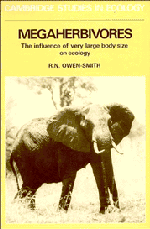Book contents
- Frontmatter
- Contents
- Preface
- 1 Prologue
- 2 Morphology, evolutionary history and recent distribution
- 3 Food and other habitat resources
- 4 Space–time patterns of habitat use
- 5 Body size and nutritional physiology
- 6 Body size and feeding ecology
- 7 Social organization and behavior
- 8 Life history
- 9 Body size and sociobiology
- 10 Body size and reproductive patterns
- 11 Demography
- 12 Community interactions
- 13 Body size and population regulation
- 14 Body size and ecosystem processes
- 15 Late Pleistocene extinctions
- 16 Conservation
- 17 Epilogue: the megaherbivore syndrome
- Appendixes
- References
- Index
5 - Body size and nutritional physiology
Published online by Cambridge University Press: 01 June 2011
- Frontmatter
- Contents
- Preface
- 1 Prologue
- 2 Morphology, evolutionary history and recent distribution
- 3 Food and other habitat resources
- 4 Space–time patterns of habitat use
- 5 Body size and nutritional physiology
- 6 Body size and feeding ecology
- 7 Social organization and behavior
- 8 Life history
- 9 Body size and sociobiology
- 10 Body size and reproductive patterns
- 11 Demography
- 12 Community interactions
- 13 Body size and population regulation
- 14 Body size and ecosystem processes
- 15 Late Pleistocene extinctions
- 16 Conservation
- 17 Epilogue: the megaherbivore syndrome
- Appendixes
- References
- Index
Summary
Introduction
An animal's food choice is constrained by its metabolic requirements and by the functional anatomy and physiology of its digestive tract. In this chapter I consider how these constraints operate, and how their effects vary with body size. For example, larger animals generally eat more food per day than smaller animals. However the more critical sorts of questions that I will ask are these:
Does a 5000 kg elephant bull eat 1000 times as much food per day as a 5 kg dikdik?
What allometric relation best predicts the trend in food intake with increasing body mass?
Do particular species deviate notably from the overall trend, in particular those of very large body size?
In this chapter and others of its kind I will introduce each section with a deductive proposition as to how the particular attribute being considered ought to vary in relation to body mass. I will then test whether the published data on large herbivores support or refute this starting hypothesis. The statistical technique to be used is that of least squares regression. The reader must first be forewarned of potential pitfalls in this method, as discussed by Peters (1983).
Standard regression techniques assume that the X-variate (i.e. body mass in our case) is measured without statistical error. Generally I will use the mean body mass for the age/sex category being considered (see Appendix I), except in those few cases where more precise figures are available for the particular animals observed. Some error may be introduced here, but it should be fairly minor on a log scale.
[…]
- Type
- Chapter
- Information
- MegaherbivoresThe Influence of Very Large Body Size on Ecology, pp. 69 - 81Publisher: Cambridge University PressPrint publication year: 1988
- 2
- Cited by



